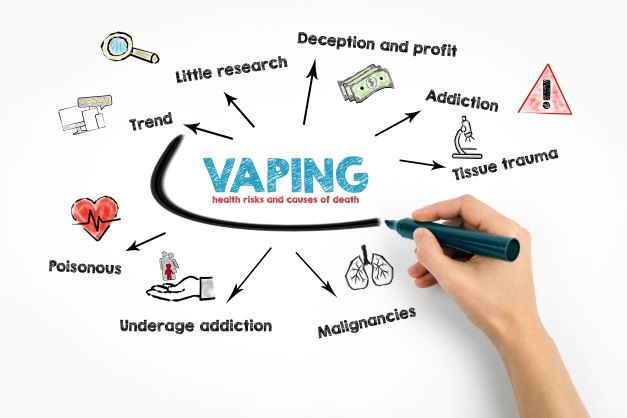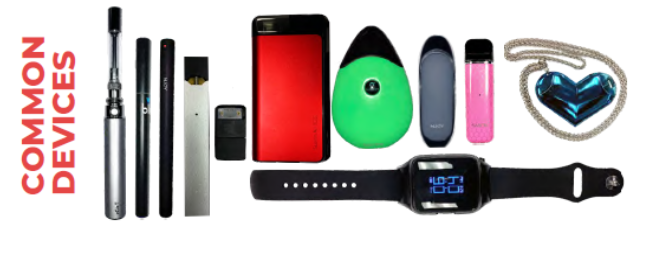| |  | | | Vaping devices, also called vapes and e-cigarettes, are battery-operated devices that heat a solution (e-liquid) to create an aerosol that the user inhales. The e-liquid typically contains nicotine, flavorings, and other chemicals, usually dissolved into propylene glycol and/or glycerin. Vapes can resemble traditional tobacco cigarettes, cigars, or pipes, but the devices most popular among youth commonly resemble everyday objects like USB drives, pens, and markers. Vapes are considered tobacco products because most of them contain nicotine, which comes from tobacco. | | |  | Image credit: rethinkvape.org | | | | | | KNOW! The Latest Statistics | | | | Data from the 2022 National Youth Tobacco Survey, conducted by the Food and Drug Administration and the Centers for Disease Control and Prevention, was released in early October. Here are some key takeaways about youth e-cigarette use: -
In 2022, about 1 in 10, or more than 2.5 million, U.S. middle and high school students used e-cigarettes in the past 30 days. -
14.1% of high school students and 3.3% of middle school students reported current e-cigarette use in 2022. This is up from 2021 when 11.3% of high school students and 2.8% of middle school students reported current e-cigarette use. -
Nearly 85% of current users used flavored e-cigarettes, with fruit flavors being the most popular, followed by candy, desserts, or other sweets. -
More than a quarter (27.6%) of current youth e-cigarette users use an e-cigarette product every day. -
More than 4 in 10 youth e-cigarette users report using e-cigarettes at least 20 of the last 30 days. -
The most used device among current users was disposables (55.3%), followed by prefilled/refillable pods or cartridges (25.2%). -
The most popular brands of e-cigarettes among youth were Puff Bar (14.5%), Vuse (12.5%), Hyde (5.5%), and SMOK (4%). | | KNOW! Why The Statistics Matter | | | | Vapes Are Not Safe It is a common misconception that vaping is a healthy alternative to smoking traditional cigarettes. Research so far suggests that vaping devices may be less harmful than combustible cigarettes when people who regularly smoke switch to them as a complete replacement. However, nicotine in any form is highly addictive, and aerosol from vapes poses a health risk. Just because vaping might be "safer" than smoking traditional cigarettes does not mean that vaping is safe. | | | | Most Vapes Contain Nicotine Nicotine is a highly addictive chemical found in over 90% of vape products. Even vape products that claim to be nicotine-free have been found to contain trace amounts of nicotine. A single pod for a vape often contains more nicotine than 20 cigarettes. No amount of nicotine is safe for youth. Young people who use tobacco products are uniquely at risk for long-term, long-lasting effects of exposing their developing brains to nicotine. In addition to learning and cognitive deficits, and susceptibility to addiction, these risks include mood disorders and permanent lowering of impulse control. Preventing the use of these devices among youth and young adults is imperative as research suggests that approximately 9 out of 10 adult tobacco users first used them during adolescence. Nicotine is a toxic substance. It raises your blood pressure and spikes your adrenaline, which increases your heart rate and the likelihood of having a heart attack. Eating, drinking, or otherwise absorbing large amounts of nicotine can lead to nicotine poisoning, especially in children. Symptoms of poisoning include nausea, vomiting, seizures, and respiratory depression. In high enough doses, nicotine can be deadly. | | | | Some Vapes Contain THC Many youth, especially older teens, are using vaping devices to consume THC, the psychoactive ingredient in marijuana that produces a high. The level of THC in vapes can be far higher than in smoked marijuana. Some marijuana vapes look like nicotine vaping devices and are available in youth-friendly flavors. The THC inhaled when vaping enters the bloodstream quickly and can lead to overuse, addiction, and other negative health consequences. Vaping marijuana can cause bloodshot eyes, dry mouth, increased appetite, and mood swings and can increase the risk of depression, psychosis, and suicidality. Marijuana use can also result in impaired attention, learning, problem-solving skills, memory, reaction time, and coordination. Additionally, the inhalation of vitamin E acetate, an additive in some THC-containing vapes, has been implicated in the recent string of vaping-related lung injuries and deaths known as EVALI (E-cigarette, or Vaping Product, Use Associated Lung Injury). | | | | All Vapes Contain Harmful Chemicals Even without nicotine or THC, vaping poses health risks. The aerosol that goes into your lungs and is exhaled out is not just water vapor. A study of some e-cigarette products found that the vapor contains known carcinogens and toxic chemicals, as well as potentially toxic metal nanoparticles from the device itself. These chemicals can cause serious lung damage. There are also reports of lung illnesses and deaths related to inhalation of certain vaping oils into the lungs, which have no way to filter out toxic ingredients. Chemicals found in aerosols include: -
formaldehyde -
diacetyl -
acetaldehyde -
nitrosamines -
acrolein -
diethylene glycol -
propylene glycol -
vegetable glycerin Even though some chemicals are recognized as safe to have in food and drinks, they are not necessarily safe to breathe into your lungs, especially when heated. No vaping product is FDA approved for safe use. | | | | Vapes Are Popular Among Youth And Young Adults Vaping devices are the most used form of nicotine among youth in the U.S. There are many reasons why vapes have become so popular among youth and young adults. | | | | Many young people are misinformed about the health risks associated with vaping. Some research indicates that many teens do not realize that vaping cartridges contain nicotine, instead believing that they contain only flavoring. Additionally, there is a widespread belief that vaping devices are safer than cigarettes. Young people may not know about the harmful chemicals in the aerosol or may not recognize that safer ≠ safe. | | | Vaping devices are marketed to appeal to youth. Vaping products are easily available in stores and online, even though tobacco products are illegal to purchase for anyone under the age of 21 in Ohio. The sweet flavors of many vapes make them more appealing to young people than cigarettes. There is widespread advertising for vaping devices, including via media like television, where advertising for conventional tobacco products is prohibited. Additionally, some vaping products are less expensive than cigarettes, which may motivate youth to choose vapes over other tobacco products. | | | Young people are curious. Many young people are interested in vaping because they are new products that spark their curiosity. Seeing a friend or peer vaping may increase a young person's interest in trying out this trend. | | | | KNOW! How To Start A Conversation About Vaping | | | | Learn the Facts Learning the health risks associated with vaping allows you to know how to respond when young people in your life ask questions or express their opinions about vaping. Using the information in this newsletter and the additional resources provided can help you prepare to engage in a productive conversation about vaping. Get in the Right Mindset The goal of your conversation should be to have an open dialogue about vaping, not to deliver a lecture. Approach the topic in a calm, reasonable way and be ready to listen. Try to avoid criticism and punishment and instead focus on health and safety. Try to Understand Why Many young people start vaping because they are curious, have seen family and friends vape, or think it's cool. Young people may continue to vape to cope with difficult emotions like anxiety, boredom, loneliness, or sadness. Understanding the reason why your young person vapes/might start vaping will help you find healthy ways to address their needs and provide appropriate resources. Find the Right Moment A conversation will be more productive when it occurs naturally, rather than feeling like a lecture. Look for opportunities to casually discuss vaping. Potential conversation openers include: news stories, passing a vape shop, seeing someone vaping on TV or in person, seeing an advertisement for vaping, or letters from the school about vaping policies. Start the Conversation Get the conversation going by asking open-ended questions like, "What do you think about vaping?" or "What do you enjoy about vaping?" and "How does vaping make you feel?" if they currently vape. Asking these kinds of questions allows you to hear their perspectives, acknowledge the potential appeal of vaping, and help them to weigh the risks against their perceived benefits. Emphasize that you care about them and their health while offering honest, accurate, science-based information. Try to have these conversations before the young people in life start vaping, but know that it is never too late to start talking. Remember to keep the conversation going: it's okay if the conversation takes place in bits and pieces over time. If you're unsure where to begin, ask for support. Healthcare providers can offer support and resources for you and the young people in your life. For responses to frequently asked questions, see this resource from the Surgeon General: Talk with Your Teen About E-cigarettes: A Tip Sheet for Parents | | | | | | Feel free to check out these resources! | | | | | | | | | | | | Prevention Action Alliance
6171 Huntley Road Suite G | Columbus, Ohio 43229
6145409985 | contact@preventionactionalliance.org | | | | | | | | | | | |